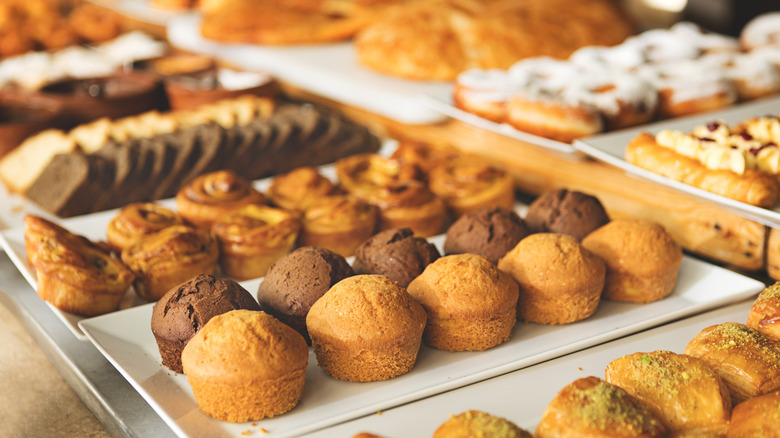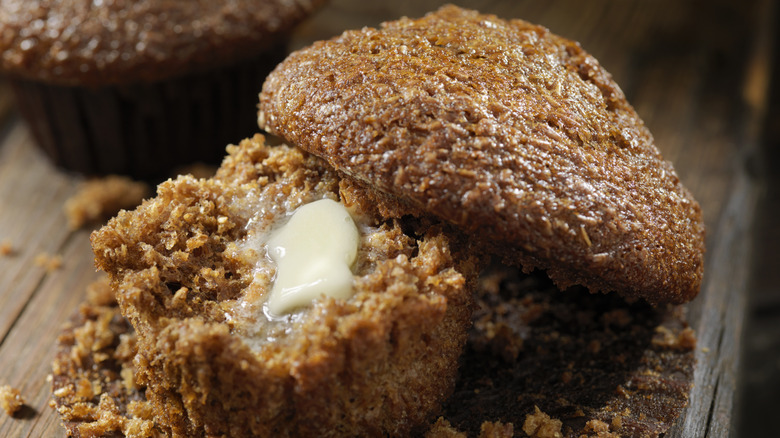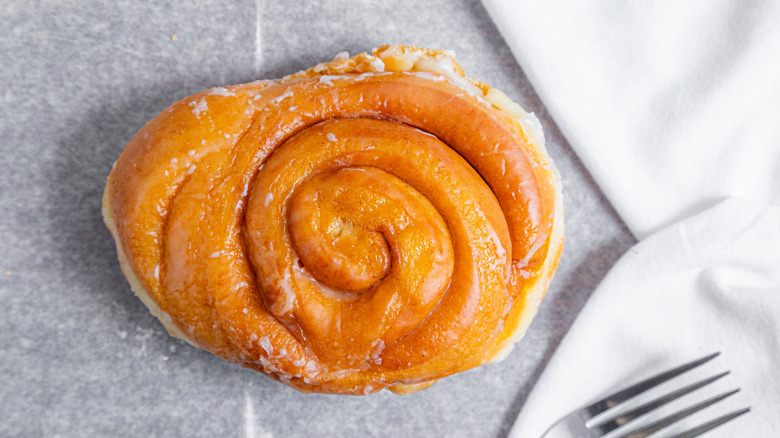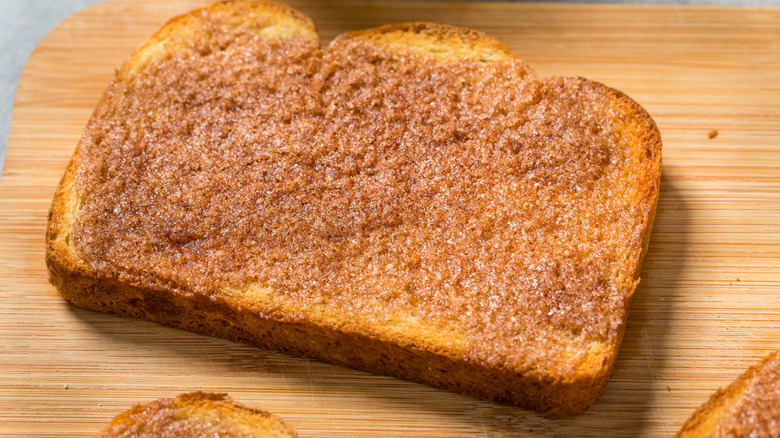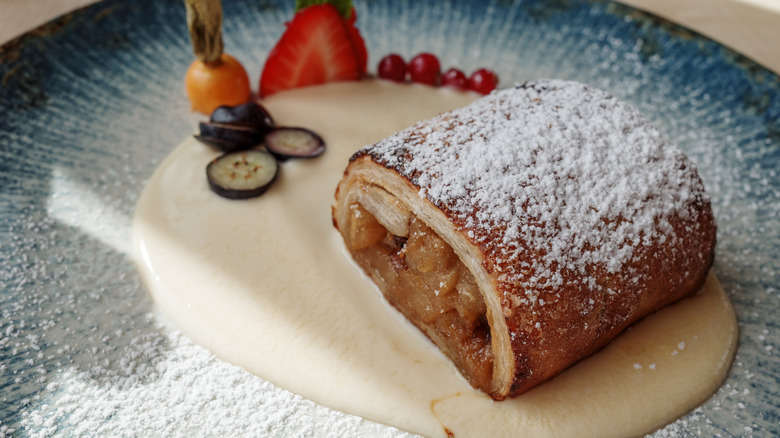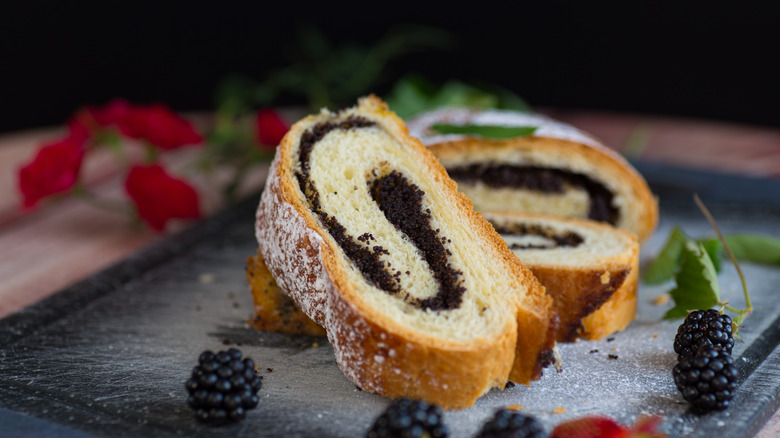7 Old-School Breakfast Pastries That Need To Make A Comeback
We may receive a commission on purchases made from links.
Even if you're not a morning person, the right breakfast can provide the incentive you need to skip the snooze button and re-enter the world of the living. If you're a fan of savory breakfasts, you'll need to be blessed with an early-bird family member who likes to cook or be the one who is motivated enough to get out of bed and make breakfast; those eggs and hash browns aren't going to fry themselves. But if you crave sweets for breakfast, you've got it easy: just plan to have some treats from the bakery on hand and grab one once your coffee is brewed and poured.
Sometimes, however, our go-to breakfast pastries can get old, leaving some of us to eagerly seek out the next hot new thing. But as many of us know from experience, while trendy treats can be a fun changeup, you may also end up waiting in a long line for a pricy pastry that might not live up to the hype. So the next time you want to mix up your breakfast pastry routine, take the less-trodden path to the past. The old-school breakfast pastries your parents or grandparents might have enjoyed at the start of the day once upon a time may not be as easy to find at a supermarket bakery as they used to be. But many are easy enough to make for even novice bakers, and the others are well worth the hunt.
Date nut bread
A bakery staple in the '60s and '70s, date nut bread is a rich, sticky treat that made frequent appearances on the breakfast table as well as in lunch boxes. As its name suggests, it's a quick (unyeasted) sweet loaf filled with chopped dates and studded with nuts, typically walnuts or pecans, which add a welcome bit of crunch. The dates not only added flavor, but contributed much of the bread's signature sweetness and stickiness. During its heyday, date nut bread was so beloved that it even became a favorite ice cream flavor at Baskin-Robbins.
While you might happen upon a loaf during the holiday season, date nut bread has mostly disappeared from supermarket shelves. And our breakfast tables are worse for the loss. If you've never had date nut bread, think of it as sticky toffee pudding in sliceable form. Yes, it's that rich –- and that good. If you can't find it in a bakery or supermarket, find an old cookbook and make it yourself; if you can pull off banana bread, date nut bread is just as easy. Try it the old-school way, slathered with a thick layer of cream cheese, for a breakfast that will keep you happy and energized all morning.
Bran muffins
Back in the day, diners prided themselves on choosing bran muffins for breakfast because they thought they were healthy. We should have known they weren't. The dense, sweet, sticky muffins were typically loaded with molasses and sugar and typically eaten with a big gob of butter. Needless to say, they were hardly the low-cal option we wanted to believe they were. So if the idea of bran muffins make you think of a dry, tasteless lump of fiber, these old-school muffins would have come as a happy surprise.
Bran muffins became a popular comfort food in part because they were so easy to make at home. In the '70s and '80s, typical bran muffin recipes called for an entire box of bran flakes. This would make a giant batch of batter that would keep in the refrigerator for several weeks –- whenever a craving for fresh muffins hit, all you had to do was scoop some batter out and bake it up. However, nutrition-minded eaters eventually wised up and abandoned bran muffins for lower-fat, more healthful options, disappointed that their old favorite would not, as previously believed, reduce their cholesterol. But none of this changes the fact that they're delicious –- and as one Redditor called them, a "sorta healthy, but secretly a cupcake" treat. For a modern, lower-fat version loaded with fall flavors, try our apple molasses bran muffins for yourself.
Honey buns
Despite their folksy, homespun name, honey buns originated as an industrial pastry. According to one local legend, a bakery in Kentucky invented them in the 1950s as a variation on the store's cinnamon rolls. And honey buns do look a bit like flat cinnamon rolls, but are fried, rather than baked, and made from a honey-flavored dough. In short, they're basically hole-less, honey-flavored glazed doughnuts. They lend themselves well to mass production, so if you remember them, you most likely picture them in plastic pouches from a vending machine or convenience store display.
And if you haven't had them, trust us when we say they're every bit as sweet as they sound — so if you have a hardcore sweet tooth, they'd be worth seeking out. The generously sized buns, sweetened with honey and topped with a thick layer of sugary glaze, can contain up to 680 calories and 50 grams of fat, so they make no pretense of offering any nutritional benefits, unless you're in desperate need for sugar, fat, and comfort. This may be why they've fallen out of favor in recent years; many of us prefer something a bit fancier if we're going to splurge on sweets. But this could also explain their enduring popularity among a population hungry for affordable comfort: prison inmates. Enterprising prisoners found that honey buns not only make a good base for makeshift birthday cakes, their high sugar content makes them easy to ferment into contraband wine.
Cinnamon toast
Cinnamon Toast Crunch has been a beloved and popular cereal since the '80s, and for good reason. After all, it was inspired by the delicious breakfast classic that is cinnamon toast, which is a piece of buttered toast with a crispy baked topping of cinnamon sugar. It's a puzzle why this simple treat is not the breakfast fixture it once was. Humans have been eating cinnamon toast in some form for centuries, and as far as we're concerned, it's a timeless offering that should be more common at modern day breakfast setups. It's not only one of the most kid-friendly breakfasts imaginable, it's ridiculously easy to make –- you can even throw it together in an air fryer in just five minutes.
It's also a dish with deep roots. Cinnamon toast first emerged in the 1400s in Europe as a shortcut version of French toast, and later became popular in the U.S. Because it didn't take much to prepare and just about everyone liked it, including children, it was even served in railroad dining cars, whose managers sought to keep multiple generations of passengers happy but had limited space in which to cook. But don't let its simplicity fool you: Cinnamon toast tastes like more than the sum of its parts. In "1,000 Foods to Eat Before You Die," former New York Times food critic Mimi Sheraton gave cinnamon toast a place of honor as one of the most important American foods on her list.
Apple strudel
Apple strudel, a decadent treat of apple filling wrapped in layers of thin, flaky pastry, is an Austrian specialty with roots in the Byzantine Empire –- it's thought to be a fruity relative of baklava. It's a signature dish in Vienna's many coffeehouses, and variations of it occur around the world, including in the U.S. which even has a National Apple Strudel Day (it's June 17, if you're interested in celebrating).
The hardest part of a Stateside strudel celebration is finding a good example of the pastry. Strudel fans procure theirs from specialty European bakeries or online from strudel specialists. Good examples of strudel are increasingly difficult to find in supermarkets, since it's difficult and time-consuming to make. To create the paper-thin dough, bakers must painstakingly hand-stretch it until it's thin enough to read through without tearing it or creating any holes. (I can state from my own cooking school experience that this is even trickier than it sounds.) Only then can you top it with apple filling and very gently roll it up before baking. Should you manage to score a good apple strudel, enjoy it with whipped cream and a moment of appreciation for the baker's skill and patience.
Poppy seed Danish
Poppy seed filling –- a nubby, deep-black mixture of ground poppy seeds, sugar, butter, and eggs – has long been a staple of Eastern European and American Jewish baking. But apart from a hot moment in the 1990s, when a blueberry poppy seed cake took the grand prize in the Pillsbury Bake-Off, poppy seed pastries have mostly fallen off the American radar. Sure, lemon poppy seed muffins and cakes make frequent appearances at our favorite bakeries, and smart bakers know a sprinkling of poppy seeds can add sparkle and crunch to cookies. However, pastries that put poppy seeds front and center are few and far between. But they deserve a comeback -– the mild, nutty flavor of poppy seed filling is a refreshing changeup from the super sweet, fruity options we're used to digging into.
They're not as easy to find as they used to be, though. Your best bet for scoring one would be a traditional European or Jewish bakery. You might find the Danish specialty tebirkes, a poppy seed-filled pastry. Poppy seed filling is also common in kolaches, a Czech pastry popularized in Texas by the state's large Czech population. In Jewish baking, poppy seeds also fill hamantaschen, big triangular cookies most commonly served during the early spring holiday of Purim. The only catch? While they can't make you high, poppy seeds can cause you to test positive for codeine on drug tests. So if you are regularly drug tested for whatever reason, it might be best to stick with other flavors.
Prune Danish
We know. Prune Danish was a punchline even in your grandfather's time. But track one down at a traditional Eastern European or Jewish bakery and taste it with an open mind. The dense, intensely fruity, slightly tangy filling is a great foil for the sweet, fluffy pastry.
Earlier generations were well aware of this; in decades past, prune filling was a standard bakery option for Danishes and other pastries, along with the more-familiar cherry, apricot, and cheese fillings. But for whatever reason, it's fallen to the wayside. Perhaps its color –- a tarry purplish-black –- is less appealing to modern diners than the jewel tones of other fruit fillings. Or perhaps prunes' famed (or notorious) laxative qualities have scared people off. This, however, is a non-issue; a single prune Danish probably won't do much. Prunes do contain sorbitol, a sugar alcohol that can cause diarrhea in doses of 20 grams or more, but a serving of five or six prunes — more than would likely occur in the filling of a single Danish — contains only 6 grams of sorbitol. So go ahead, enjoy a prune Danish if you can find one, and ignore the haters –- they're the ones missing out.
